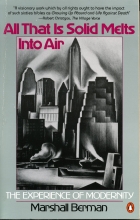
All That Is Solid Melts Into Air
The Experience of Modernity
Berman, Marshall
Publisher: Penguin, New York, USA
Year First Published: 1982
Year Published: 1988
Pages: 384pp ISBN: 0-14-010962-5
Library of Congress Number: CB425.B458 Dewey: 909.82
Resource Type: Book
Cx Number: CX7770
Berman examines the clash of classes, histories, and clutures in the modern world, and ponders our prospects for coming to terms with the relationship between a liberating social and philosophical idealism and a complex, bureaucratic materialism.
Abstract:
In All that Solid Melts into Thin Air Berman confronts the central ambiguity of modernism, the attempt by men and women to become objects of modernization in order to understand the world and cultivate it into their home. Berman creates an open-ended dialogue with the reader such that he/she may include their own experiences as an extension of the three-phased history of modernism he outlines within the book. These three historical phases of modernity begin with the first phase ranging from the 16th century to the 18th century, when human civilization is still adapting to modern life. The dichotomous second phase beginning in the 1790s, when concepts of modernity materialized, is initially characterized by a revolutionary public. In the latter half, 19th century society becomes preoccupied with a nostalgic desire to gain knowledge about non-modern civilizations. Finally, with the last phase in the twentieth century, modernity as a process embraces the entire world, yet simultaneously becomes fragmented as society no longer relates to modern art and cultural forms in a useful manner. This is because too many distinct and contradictory ways of understanding modernity render it incapable of lending meaning to people's lives. Berman attempts to address this challenge of fragmentation, caused by the advent of post-modernism in the 70s, by proposing a reappropriation of the dialectical 19th century modernists. Consequently, we will reconnect the contradictory forces of modernist society; including disjointed geographical borders, identities and cultures; that present themselves as obstacles to understanding the modern world.
Influenced by thinkers including Rousseau, Nietzsche, Marx, Baudelaire, Goethe and Kierkegaard, the initial three sections of the book examine the impact of works by modernist thinkers. In the first section we learn how Goethe's Faust expresses the modernist quest, whereas the second section questions if Marx's Communist Manifesto (the source for the book title) can account for the relationship between bourgeois economy and modernist culture. Next Berman discusses the importance of Baudelaire's art in providing nineteenth century society with an awareness of their modernity and modern art forms. In contrast, the final two sections of the book focus on geographical places that exemplify modernism. Therefore, section five discusses how Russia experienced economic underdevelopment in opposition to the West's growth. In particular, Berman examines how the imperial and cosmopolitan city of St. Petersburg is a source to explore modern life. The final section of the book illustrates how New York has simultaneously come to represent modernist ruin, modern life imagined and modern man's capacity to build.
[Abstract by Amanpreet Dhami]
Table of Contents
Preface
Introduction: Modernity-Yesterday, Today and Tomorrow
I. Goethe's Faust: The Tragedy of Development
First Metamorphosis: The Dreamer
Second Metamorphosis: The Lover
Third Metamorphosis: The Developer
Epilogue: The Faustian and Pseudo-Faustian Age
II. All That Is Solid Melts Into Air: Marx, Modernism and Modernization
1. The Melting Vision and Its Dialectic
2. Innovative Self-Destruction
3. Nakedness: The Unaccommodated Man
4. The Metamorphosis of Values
5. The Loss of a Halo
Conclusion: Culture and the Contradictions of Capitalism
III. Baudelaire: Modernism in the Streets
1. Pastoral and Counter-Pastoral Modernism
2. The Heroism of Modern Life
3. The Family of Eyes
4. The Mire of the Macadam
5. The Twentieth Century: The Halo and the Highway
IV. Petersburg: The Modernism of Underdevelopment
1. The Real and Unreal City
"Geometry Has Appeared": The City in the Swamps
Pushkin's "Bronze Horseman": The Clerk and the Tsar
Petersburg Under Nicholas I: Palace vs. Prospect
Gogol: The Real and Surreal Street
Words and Shoes: The Young Dostoevsky
2. The 1860's: The New Man in the Street
Chernyshevsky: The Street as Frontier
The Underground Man in the Street
Petersburg vs. Paris:Two Modes of Modernism in the Streets
The Political Prospect
Afterword: The Crystal Palace, Fact and Symbol
3. The Twentieth Century: The City Rises, the City Fades
1905: More Light, More Shadows
Biely's Petersburg: The Shadow Passport
Mandelstam: The Blessed Word With No Meaning
Conclusion
V. In the Forest of Symbols: Some Notes on Modernism in New York
1. Robert Moses: The Expressway World
2. The 1960's: A Shout in the Street
3. The 1970's: Bringing It All Back Home
Notes
Index
Subject Headings


